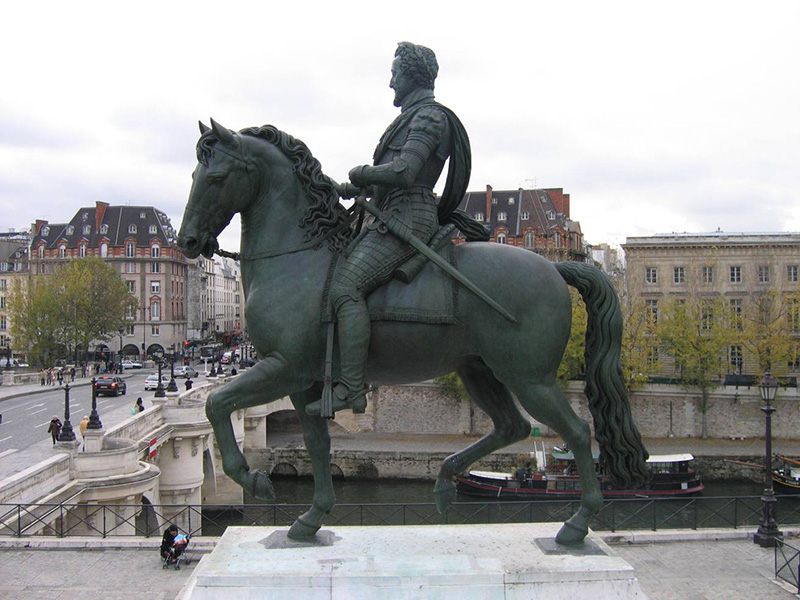Henri IV and the Pont Neuf
Joan DeJean, How Paris Became Paris: The Invention of the Modern City (New York: Bloomsbury,2014), p.23.
The construction of a new bridge over the Seine was initiated by Henri IV's predecessor, the last king of the Valois dynasty, Henri III, who laid the first stone in May 1578. Some early projects conceived of a very different bridge, most notably, with shops and houses lining each side. In 1587, construction was just becoming visible above the water line when life in Paris was upended by religious violence. With the city in chaos, work on the bridge ceased for more than a decade. In April 1598, Henri IV signed the Edict of Nantes: the Wars of Religion were officially over. A month earlier, the new king had already registered documents announcing his intention to complete the bridge. . . .
By June 1603 it was nearly ready-ready enough at least so that Henri IV, never a patient man, decided that it was high time to show off the new public work. Some had already tried to use it to cross the Seine; all had taken a tumble and ended up in the river. However, a contemporary quoted Henri IV as having explained that "none of them was a king." The monarch had planks laid across the piles to form what this contemporary described as a "still shaky" structure, and in true kingly fashion, became the first to cross the bridge successfully -- even managing to return home to the Louvre in time for dinner.
James H.S. McGregor, Paris from the Ground Up (Cambridge, Mass.: Harvard University Press, 2009, pp.166-167.
Although Henri IV was not the developer of the Pont Neuf, it is his statue, rather than that of his predecessor, which stands in the center of a small plaza between the bridges. The statue of Henri IV was commissioned by his widow, Marie de' Medici, in 1614, four years after the king's assassination. The bronze figure in full armor, crowned with the victor's wreath of laurel and holding the baton of a marshal of France, was the first equestrian statue ever erected in the city. Designed by a French sculptor, it was cast by Pierre Tasca , whose name is undoubtedly Italian.
The monument itself reflects Marie's Florentine background . Bronze equestrian statues of military heroes made their first modern appearance in northern Italy. The Florentine sculptor Donatello created a mounted image of the Paduan military leader known as Gattamelata in the midfifteenth century that inspired many imitators. All of these works, many by Florentines, were based on the ancient equestrian statue of Marcus Aurelius that stood in front of the Lateran basilica in Rome until the mid-sixteenth century, when it became the centerpiece of Michelangelo's redesign of the Capitoline hill. Though the statue of Henri depicts him as an emperor at war, its location near the watermill that he gave to the city was probably not accidental. Water was the frequent gift of Roman emperors, and it seems likely that Henri, or perhaps Marie, had this imperial association in mind when commissioning the waterworks.
The seventeenth-century statue was torn down during the Revolution, melted, and recast into cannons. After the restoration of the monarchy [in 1815], a new statue was commissioned, and -- in an unusual act of artistic revenge -- bronze statues of Napoleon were melted down to create the new figure. The sculptor, François-Frederic Lemot, proved to be a devotee of the emperor, however, and he reputedly placed a small bronze of Napoleon, along with some other seditious artifacts, in the horse's hollow belly.
Joan DeJean, How Paris Became Paris: The Invention of the Modern City (New York: Bloomsbury,2014), p.23.
